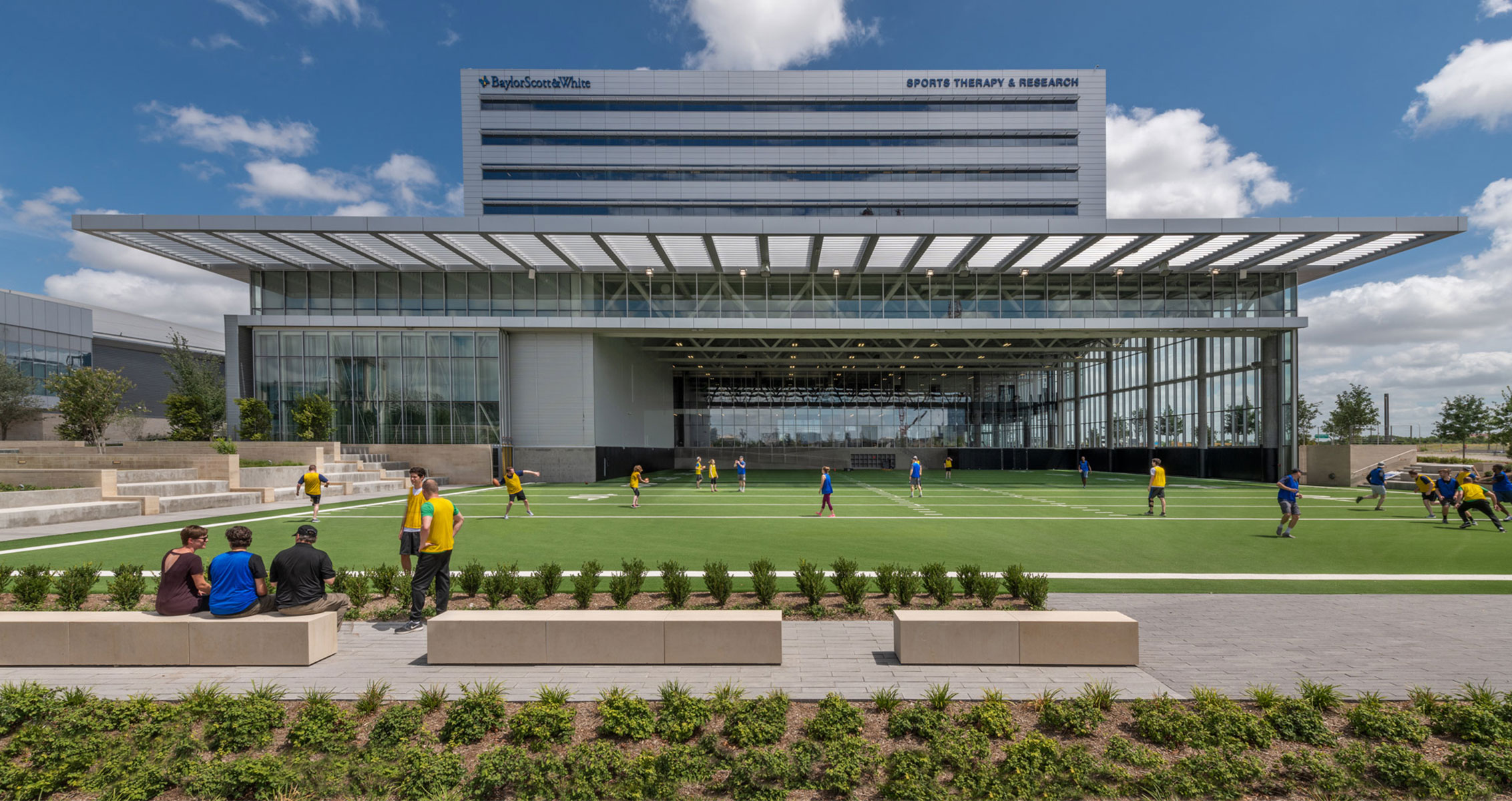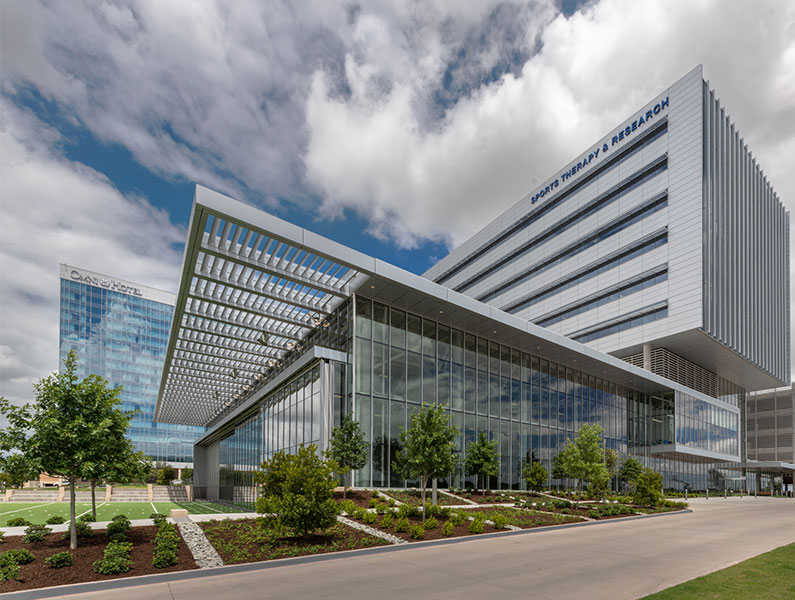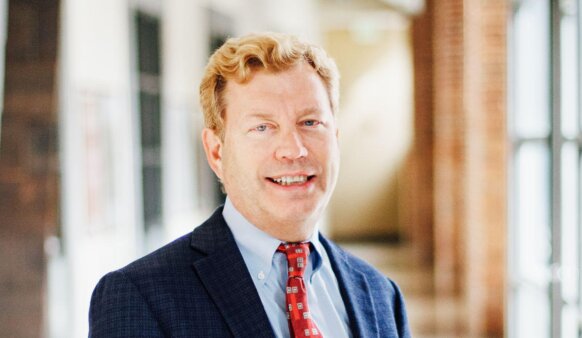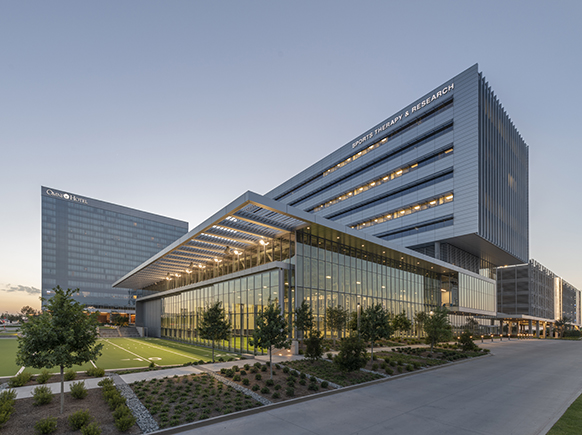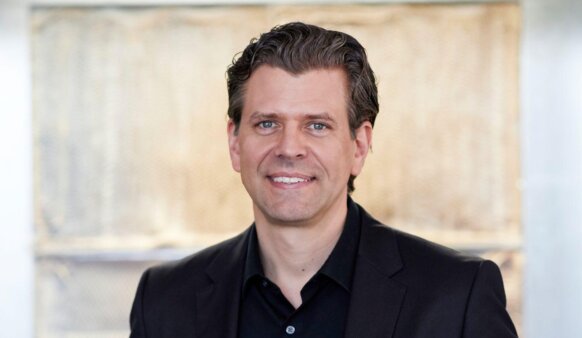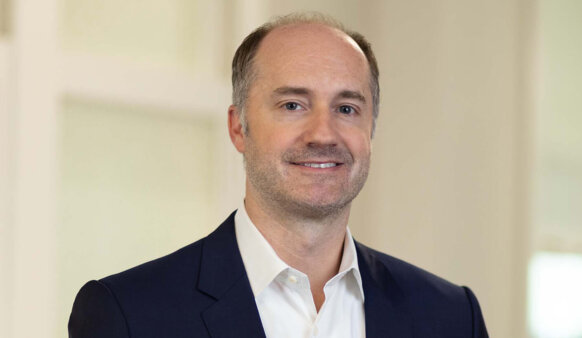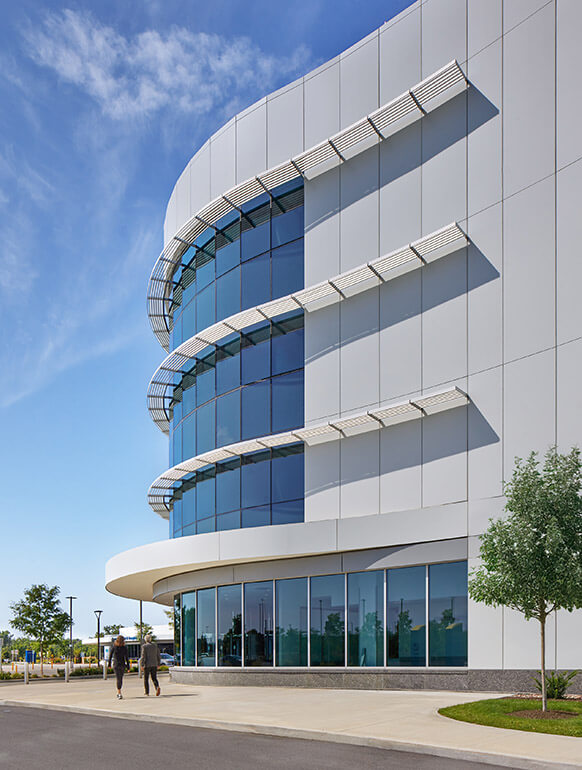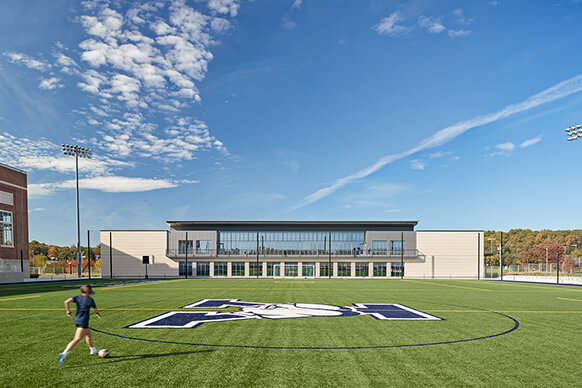- Adjacent to the Dallas Cowboys headquarters, the complex is a first-of-its-kind collaboration between a major healthcare provider, an NFL team, and a local school district to promote community health and well-being.
- The facility is open to all, welcoming patients ranging from non-athletes and student athletes to professional athletes and even the Dallas Cowboys themselves.
- The complex’s architecture and design enable patients to experience the full spectrum of physical performance – from injury prevention to training to healing and recovery – in one place.
- The complex illustrates ‘design convergence’ – a fusion of healthcare, science and technology, sports and recreation, workplace, branded environment, urban design, and civic architecture typologies.
From its retractable glass façade that opens to an indoor/outdoor football field to its light-filled strength training room surrounded by glass walls, the new Baylor Scott & White Health Sports Therapy & Research complex puts human health and sports performance on public display – and for good reason.
The 300,000-square-foot complex, which celebrates today its grand opening on the Dallas Cowboys-themed campus known as The Star, is an educational opportunity for visitors as much as it is a healthcare destination for recreational and professional athletes. Upon entering through the front doors, patients and visitors observe the science of athleticism and sports medicine and intuit the relationship between physical activity and well-being. Patients then have the opportunity to use the same facilities for their own healthcare needs. As a result, everyone comes away inspired by the combined brand power of the Dallas Cowboys and Baylor Scott & White Health, and motivated to improve their own health and fitness.
“The complex is designed to showcase the link between active lifestyles and physical health so that every visitor leaves feeling more informed and inspired,” says Ron Stelmarski, principal at architecture firm Perkins&Will and lead designer of the complex. “Wellness education and inspiration, coupled with a holistic approach to diagnosis, treatment, and recovery, promote the health and well-being of a community. The Sports Therapy & Research facility is a shining example of a new kind of architecture that supports the improvement of population health through physical fitness.”
Convergence: Blending Design Typologies
At the heart of this “new kind of architecture,” Stelmarski explains, is a convergence of healthcare, science and technology, sports and recreation, workplace, branded environment, urban planning and, to a certain extent, civic design (parts of the complex can be transformed into public gathering places for community events and performances). This melding of design typologies allows Baylor Scott & White Health to offer patients an innovative “one-stop-shop” approach to sports medicine and rehabilitation services, including sports nutrition, sports psychology, orthopedics, physical therapy, occupational therapy, neuropsychology, urgent care, surgery, a brain injury program, cardiology, outpatient imaging, and a pharmacy.
In alignment with the complex’s focus, the Gatorade Sports Science Institute, a leader in hydration and nutrition science, is housed on the complex’s second floor. Outside, a network of publicly accessible walk, run, and bike trails keeps the facility well-connected to the community and integrated with the surrounding Star campus.
“We’re seeing a fascinating trend emerge at the intersection of sports performance and healthcare design-one that we think could start a sea change in population health nationwide,” says Don Dethlefs, principal and chair of Perkins&Will’s sports, recreation, and entertainment practice. “In each case, our clients have shared one vision: help entire communities achieve holistic health by improving individuals’ physical fitness.”
Other Perkins&Will projects illustrating this trend include the PPL Center (opened in September 2014); the UCLA Health Training Center, home of the Los Angeles Lakers (opened in August 2017); the University of Michigan Stephen M. Ross Athletic Center (opened in October 2017); the Snyder Center at Phillips Andover Academy (opened in January 2018); the Viking Pavilion at the Peter W. Stott Center at Portland State University (opened in April 2018); and Northwestern University’s Ryan Walter Athletics Center (set to open in August 2018).
Designing a Branded Experience
The Sports Therapy & Research complex includes basketball courts, a fitness and strength training room, and an indoor/outdoor playing field. Powered by Fusionetics, a digital platform that optimizes athletic performance, decreases the risk of injuries, and speeds recovery, these facilities allow athletes to train and rehabilitate in advanced ways. And with the exception of the locker rooms, pool, and plunge room, these highly visible, prominently placed athletic facilities – surrounded by transparent glass walls and casual seating areas for onlookers – allow the whole process of rehabilitation to be observed.
“The transparency helps tell the complex’s story. It showcases the human body in motion, creating a ‘living brand’ experience that celebrates athleticism and physical fitness,” Stelmarski says. “The openness and visual interconnectivity of the spaces lend a soft, human quality to the otherwise hard, data-driven science of sports medicine.”
At the same time, the complex is also designed to invoke a sense of strength, durability, and precision – attributes of the athletes who seek treatment there and the care teams who provide care. This is accomplished through a crisp, clean material palette composed primarily of concrete, modern glass, and metal, and by complementary soothing color tones and abundant natural light. Unobstructed views and easy access to the outdoors create a feeling of revitalization and rejuvenation.
Near the main entry, a bevy of two-dimensional geometric shapes made of painted metal suspend from the ceiling of the four-story lobby like confetti, symbolizing fluidity of movement and the legerity of the physically fit body. Their organization appears arbitrary at first, but upon closer examination, the disparate shapes visually coalesce to form the Baylor Scott & White Health logo. The installation visually guides guests to a series of interactive technology stations that explore human anatomy, along with rehabilitation programs for sports-related injuries.
“The energy of this piece – part art, part branding – celebrates the possibilities of the body in motion and the interconnectivity of all its pieces and parts,” says Eileen Jones, principal and global leader of branded environments at Perkins&Will. “It is also a gateway through which visitors and patients can become more engaged in targeted physical therapies and the research behind them.”
Continued Leadership in Health and Well-Being
The design of the Sports Therapy & Research complex reflects Perkins&Will’s long-standing commitment to health and well-being – one of the firm’s greatest differentiators. Known best for seminal industry innovations like the Precautionary List, the Transparency website, the resilient building rating system RELi, the development of Portico with Google and the Healthy Building Network, and the adoption Fitwel, Perkins&Will is now on track to define and lead the industry’s Next Big Thing: convergence.
“There’s no question that sports and physical fitness play a critical role in achieving and maintaining optimal holistic health,” Stelmarski says. “To the extent that we’re contributing to the creation of a healthier world by applying our multidisciplinary design skills, we’re grateful to work with clients on these game-changing projects.”
